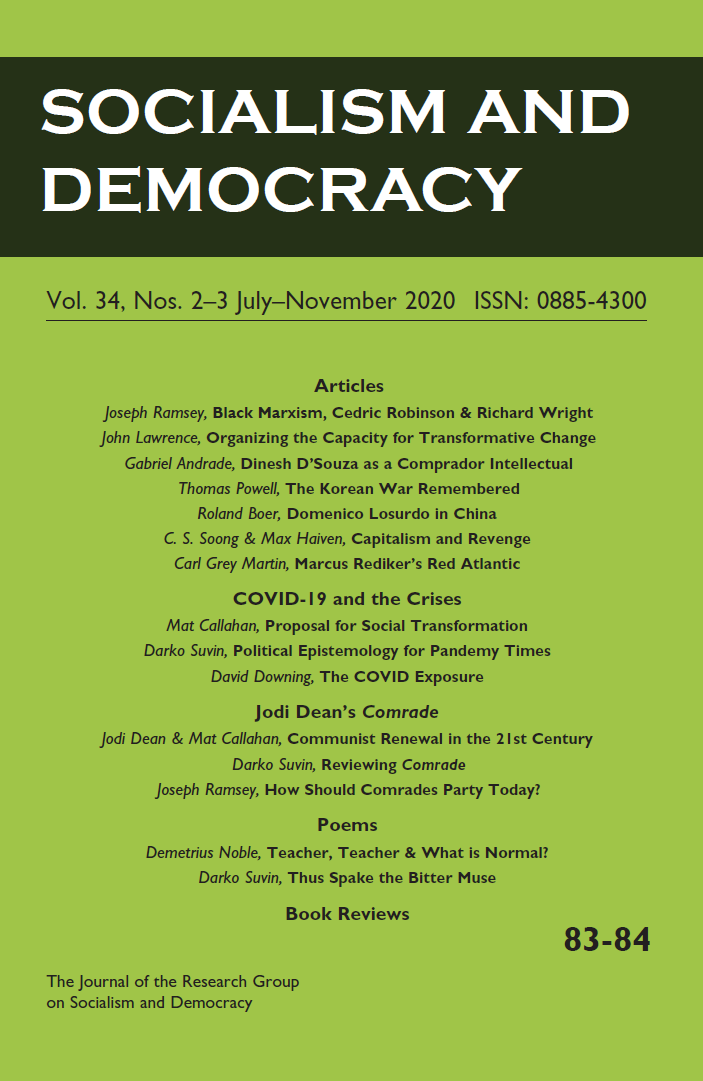Zillah Eisenstein, Abolitionist Socialist Feminism: Radicalizing the Next Revolution. (New York, Monthly Review Press), 2019, 160 pages, $20.00.
Zillah Eisenstein’s “deeply felt intellectual polemic” (13), drawn from the author’s activist and academic work throughout the past fifty years, forms an urgent call for political action. A collection of brief, self-contained essays, this short book focuses on the US-context to link accessible analyses of recent political events, such as the 2016 presidential election, to more expansive but no less digestible discussions of socialism, feminism, anti-racism and their interconnections. Taken together, the essays make a plea to weave together these approaches, thereby creating a revolutionary movement composed of shifting coalitions. The shape that such a “movement of movements” will take, as well as the relationship between reformist and revolutionary action in its midst must, as the author argues, arise from the process of political organising itself. As such, Eisenstein considers her writing to be a dialogue, directed at all women, but white women such as herself in particular. As a white woman involved in feminist organising, albeit of a different generation than Eisenstein and located on a different continent, I feel compelled to enter such a dialogue.
After outlining some “foundational queries” and challenges, the book begins with an introduction which situates Eisenstein’s writing in her personal history. Highlighting her debt to black feminist theorists and activists, Eisenstein underlines the necessity for white women to recognise the implications of their complicity in white supremacy in order to work toward its abolition. A more reflexive engagement with the ways in which her whiteness affected her organising and thinking could have served as a useful point of engagement for white women who did not, like Eisenstein, grow up in an anti-racist communist household.
Following the introduction, sixteen short essays revolve around the connection between anti-racism, socialism and feminism, as well as discussing the Pope’s “anti-capitalism”, white women’s responsibility for Trump’s election in 2016, the #MeToo movement and sexual violence in general, and the concept of a “white working class”, amongst others. The book’s indebtedness to black feminism maintains a strong presence throughout; theories of intersectionality, critiques of the carceral system and of the racialised and gendered foundation of the US state influence the discussions markedly. Eisenstein’s vision of “abolitionist socialist feminism” as described here draws on intersectional organising as articulated in 1977 by the Combahee River Collective, and a range of black feminists since. Accordingly, Eisenstein challenges the idea of unity in “womanness” and analyses of patriarchy, emphasising the inclusiveness and anti-essentialism of the term woman to include non-binary identities and trans women. However, this is somewhat contradicted by her use of essentialist and binaristic terms such as “sex class”, leaving me with questions about how the author understands and conceptualises gender and sexuality in relation to the state, capital and “race”. Her call to politicise sexual violence by locating it within the functioning of racialised capitalism is important but could have been strengthened by further illustrating these connections, for example by highlighting how these structures interact to result in the extreme levels of violence that transgender women suffer, as well as of the connection between gendered violence, heteropatriarchy and ongoing settler colonialism (see for example Arvin, Tuck and Morrill, 2013; Barker, 2017; Deer, 2015).
The book’s core argument about the interlocking problem of racist heteropatriarchal capitalism and the need for an appropriate radical response is given specific attention in section V of the book, titled “Why socialist feminism is not enough” (p. 45). Diverging from some of the shortcomings of the Marxist-feminism that characterises her early writing, Eisenstein argues that Marxist methodology must be “extended”, and that the meaning of materialism must be enlarged “beyond production to a historical materialism of racialised heteropatriarchy.” (45). She suggests that capitalism should not be understood as a singular system with class at its core: “race” and gender cannot be incorporated into class. This, for Eisenstein, has consequences for political action. It would have been interesting to learn more about how Eisenstein imagines coalitional politics, and relatedly the process of revolutionising reformist aims, to function in practice. Complicated questions around method, organisational structures, coalition and leadership could have been approached through a more in-depth discussion of the relationship between the interlocking structures of heteropatriarchy, racism and capitalism.
The sections of the book that discuss whiteness and white feminism partly revolve around the relationship between reform and revolution, and they question the possibilities for shifting alliances. They also go some way in illuminating the relationship between oppressive structures further, notably in references to white women’s role in reinforcing chattel slavery and its gendered foundations. These discussions at times inform her analysis of the contemporary US political system and political movements in productive ways. Eisenstein’s discussion of #metoo is insightful: she suggests that the movement, deeply situated in the current neoliberal moment, urgently needs to address the structural conditions for sexual violence instead of focusing on individual violent acts. Overall, her assessment of recent US mainstream feminist movements such as #metoo and the Women’s March remains optimistic, implying that these movements, despite their largely white, middle-class and liberal nature, hold potential for radicalisation, or at least for temporary coalition-building to oppose what, drawing loosely on Ta-Nehisi Coates (2017), Eisenstein terms the “first white supremacist misogynist president” (91).
This statement, as I read her, refers not to Trump’s whiteness or misogyny in itself. Rather, she describes Trump as the first president who blatantly uses misogyny and white supremacy to gain and retain popularity, thereby exposing the centrality of these structures for the functioning of the US state. Such focus on exception stands in some tension with Eisenstein’s emphasis on continuity when discussing abolitionism. Referring to the work of Ruth Wilson Gilmore, Angela Davis, Saidiya Hartman and Jared Sexton amongst others, she uses the term “newest-new” racism to denote the anchoring of contemporary racism, and its manifestations in the carceral system and police violence, in chattel slavery. Abolition for Zillah Eisenstein extends from the carceral system to the entirety of white supremacy to form “an interlocking, radically inclusive, multilayered politics of revolutionary imaginings.” (108). It would have been interesting to read more about the prison-industrial complex in its violent enforcement of gender, as well as the potential links between the practice of prison abolition and abolitionism as imagined by Eisenstein. Here, and throughout the book, in-text referencing would have allowed the reader to engage more deeply with some of the concepts and approaches that the author names as foundational to her thought. The book presents a list of “selected reading” instead, which rather than improving clarity and readability obscures the intellectual contributions of those thinkers and activists that Eisenstein seeks to honour and credit.
The last three sections of the book – “On building revolutionary connectors”, “Creating Revolutionary Possibilities” and “A few afterthoughts” are urgent but optimistic, referring to a multitude of movements already organising radically, and underlining the importance of coalition, solidarity across difference, and leadership by those most urgently affected by the harmful effects of sexism, capitalism and white supremacy. Eisenstein makes clear that these solidarities and coalitions must be fluid and shifting, and that particularities and differences are a strength rather than a weakness. Here again, she appeals to white women in particular when emphatically calling for an abandonment of liberalism, moderation and comfort and instead “confront our whiteness and its imperial privilege” – to “listen, disrupt and connect” (133). She underlines that the “next strategies are unclear” and will arise in and through the process of organising. It remains open to question whether large numbers of white women could indeed be convinced to organise and vote against their own investments in white supremacy solely out of good will.
Perhaps, the book should be read as a call for change, rather than an in-depth analysis of the contemporary political system. I recognise the importance of spontaneity and non-linearity in radical organising. However, a closer conceptualisation of the relationships between interlocking systems of oppression would have opened up more insights about revolutionary tactics. Its absence, here, can partly be attributed to the structure and scope of the book. As an essay comprised of small sections rather than a monograph, it touches on a range of topics and themes rather than engaging with any one in a sustained manner. Read as a short, punchy manifesto it serves as a timely call-to-action for a generalist audience that seeks to organise against what bell hooks calls “imperialist white-supremacist capitalist patriarchy”. I agree with Eisenstein that thinking with black radical conceptualisations of intersectionality is central to such a project.
References
Arvin, M., Tuck, E. and Morrill, A. (2013). Decolonizing feminism: Challenging connections between settler colonialism and heteropatriarchy. Feminist Formations, 25(1), pp.8-34.
Barker, J. (2017). Critically sovereign: Indigenous gender, sexuality and feminist studies. Durham, NC: Duke University Press.
Coates, T. (2017). The First White President. The Atlantic. Retrieved 11 September, 2019 from https://www.theatlantic.com/magazine/archive/2017/10/the-first-white-pre...
Deer, S. (2015). The beginning and end of rape: Confronting sexual violence in native America. Minneapolis, MN: University of Minnesota Press.
hooks, b. (2004) Understanding patriarchy. In: hooks, b. (2004) The Will to change: Men, masculinity and love. New York, NY: Simon and Schuster.
Lili Schwoerer
Ph.D. Candidate
London School of Economics and Political Science

